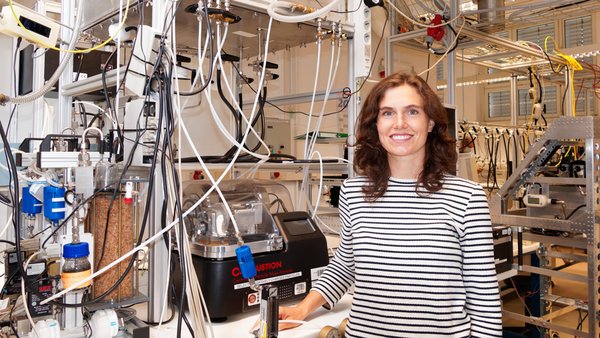New Professor for Aerosols and Cloud Microphysics
Leipzig,
03.09.2021
Joint appointment strengthens Leipzig climate research
Mira Pöhlker has taken over the professorship "Experimental Aerosol and Cloud Microphysics" at the Leipzig University, which is linked to the management of the department of the same name at the Leibniz Institute for Tropospheric Research (TROPOS). The graduate physicist most recently worked at the Max Planck Institute for Chemistry in Mainz and will now strengthen cloud research in Leipzig. Her professorship at the Institute for Meteorology at the Leipzig University is the fourth joint appointment with TROPOS. This means that all department heads at TROPOS are now also professors at the Leipzig University. Through their research on clouds, both institutes provide important insights for global climate models and thus for the strategic research field of "Sustainable Foundations for Life and Health", one of the three focal points of the university.
In addition to humidity and temperature, the formation of clouds and precipitation depends primarily on aerosol particles. These tiny fine dust particles act as nuclei for cloud droplets and ice crystals. Without them, there would be no clouds and thus no precipitation, no vegetation and no life on Earth. At the same time, fine dust can also contribute significantly to air pollution and thus threaten human health. Aerosols, clouds and their interaction are currently still among the greatest uncertainty factors in climate models. The physical properties of fine dust particles are therefore of fundamental interest and are being researched at TROPOS in the "Experimental Aerosol and Cloud Microphysics" department, which has made a name for itself worldwide with the development of aerosol measurement technology, among other things.
At the Max Planck Institute for Chemistry in Mainz, Prof. Mira Pöhlker has been investigating such processes in her working group "Cloud Condensation Nuclei". The size, concentration and chemical composition of the aerosol particles influence the growth of the cloud droplets around the cloud nuclei. How much these processes are influenced by human factors such as air pollution is one of the questions Pöhlker is investigating in Mainz. "In Leipzig, I would like to continue and expand my previous work on the interaction between aerosols and clouds. The long-standing expertise available here and my experience in field measurement campaigns worldwide - including in the Amazon rainforest - complement each other perfectly. This also fits in well with the plans of the Leipzig University and TROPOS to focus on researching the diverse exchange processes between the biosphere and the atmosphere," Mira Pöhlker reports.
"We are glad to have won over a promising young top scientist in Prof. Mira Pöhlker, who has already shown great commitment to TROPOS in the run-up to taking up the post. She will set new accents, especially in the areas of particle formation and aircraft measurements, which fit perfectly into the long-term strategy of the Institute," says Director Prof. Andreas Macke. As head of department, Pöhlker is now also responsible for the Institute's research workshops, where special measurement technology for aerosols, among other things, is developed and built.
In recent years, Pöhlker had participated in several missions of the German research aircraft HALO and can thus contribute her experience to the preparation of a HALO campaign on clouds in the southern hemisphere, which is planned as "HALO-South" for September 2025. She has also conducted research at the Amazon Tall Tower Observatory (ATTO), a 325-metre-high observatory in the Brazilian rainforest. The Amazon region is one of the most biodiverse areas on Earth and has a major impact on global climate, but is increasingly threatened by drought, forest fires and deforestation. The Amazon is a hotspot for biodiversity and climate research. An expert like Pöhlker is therefore an excellent fit for Leipzig's expertise in these fields. Tilo Arnhold
Contacts:
Prof. Dr. Mira Pöhlker,
Department Head, TROPOS Department „Experimental Aerosol and Cloud Microphysics“
Phone + 49-341-2717-7431
https://www.tropos.de/en/institute/departments/experimental-aerosol-and-cloud-microphysics
and
Prof. Andreas Macke,
Director, TROPOS
Phone + 49-341-2717-7060
https://www.tropos.de/en/institute/about-us/employees/andreas-macke
or
Tilo Arnhold,
Public Releation TROPOS
Phone +49-341-2717-7189
https://www.tropos.de/en/current-issues/press-releases
Links:
TROPOS Department „Experimental Aerosol and Cloud Microphysics“: https://www.tropos.de/en/institute/departments/experimental-aerosol-and-cloud-microphysics
Leipzig Institute for Meteorology – Profile: https://www.physgeo.uni-leipzig.de/en/instituteformeteorology/institut/profile/
Team Pöhlker at MPI-Chemistry / Minerva Fast Track Project “Cloud Condensation Nuclei”: https://www.mpic.de/4484409/team-poehlker
Distinction for Mainz cloud researcher Mira Pöhlker: https://www.mpic.de/4387369/auszeichnung-fuer-mainzer-wolkenforscherin
Amazon Tall Tower Observatory (ATTO): https://www.attoproject.org/
DFG-Programm SPP 1294 "Atmospheric and Earth System Research with HALO”: https://www.halo-spp.de/
Research Aircraft HALO: https://www.dlr.de/content/en/missions/halo.html
The Leibniz-Institute for Tropospheric Research (TROPOS) is member of the Leibniz Association, which connects 96 independent research institutions that range in focus from the natural, engineering and environmental sciences via economics, spatial and social sciences to the humanities. Leibniz Institutes address issues of social, economic and ecological relevance. They conduct knowledge-driven and applied basic research, maintain scientific infrastructure and provide research-based services.
The Leibniz Association identifies focus areas for knowledge transfer to policy-makers, academia, business and the public. Leibniz institutions collaborate intensively with universities – in the form of “Leibniz ScienceCampi” (thematic partnerships between university and non-university research institutes), for example – as well as with industry and other partners at home and abroad.
They are subject to an independent evaluation procedure that is unparalleled in its transparency. Due to the importance of the institutions for the country as a whole, they are funded jointly by the Federation and the Länder, employing some 20,000 individuals, including 10,000 researchers.
The entire budget of all the institutes is approximately 1.9 billion Euros. They are financed jointly by the Federal Government and the Länder. The basic funding of the Leibniz Institute for Tropospheric Research (TROPOS) is therefore financed by the Federal Ministry of Education and Research (BMBF) and the Saxon State Ministry of Science and the Arts (SMWK). The Institute is co-financed with tax revenues on the basis of the budget approved by the Saxon State Parliament.
https://www.leibniz-gemeinschaft.de/en/home/
https://www.bmbf.de/en/index.html
https://www.smwk.sachsen.de/

